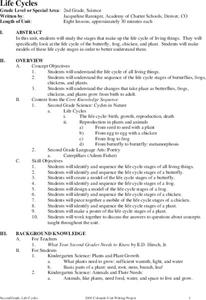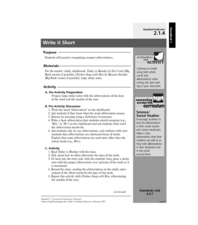Curated OER
De"compost"ition
Learners develop an understanding of the decomposition process and the parameters which influence the rate at which it occurs.
Curated OER
Agriculture in Your Life
Students examine the agricultural sources of everyday products and identify food products outside traditional farming circles. They discuss the background information, and complete activity sheets, locating various commodity locations on...
Curated OER
Where the Buffalo Roam
Second graders explore what life in the Chicago area was like hundreds of years ago. They discuss how settlers impacted the environment, and why there are no longer herds of buffalo in the Chicago area today. They read an article and...
Curated OER
Egg Structure Project
Students investigate the physical structure of an egg and the functions of the seven parts. They create a diagram and discuss each part of the egg while looking for the information, Complete lesson materials are found at a website listed...
Curated OER
The Filing Cabinet - Lesson 1
Students explore and define what is meant by Supervised Agricultural Experience is and list five benefits of having it. They identify five categories of Supervised Agricultural Experience and supply a wealth of examples. Each student...
Curated OER
Life Cycles
Students explore the life cycle of living things through the eight lessons of this unit. The butterfly, frog, chicken, and plant are inspected and form the basis of the work done in this unit.
Curated OER
Skeletal System
Young scholars discuss the need for humans to have a skeletal system and what would happen if we did not have bones. In this skeletal system lesson plan, students label each bone in the human skeletal system as a group, and then...
Curated OER
Windows on Life
Students explore and observe living development using live fertilized chicken eggs. They open the eggs approximately 72 hrs after fertilization and make observations for several days.
Curated OER
Write It Short
Students listen the books, "Today Is Monday," "Chicken Soup with Rice," and discuss how we use abbreviations for days of the week. This simple lesson is a good way to introduce the common abbreviations that young readers will encounter...
Curated OER
Oviperous Animals
Students explore animals that come from eggs using pictures and information taken from the Internet. The reading of the stories, "Chickens Aren't the Only Ones" and"Tap Tap, the Egg Cracked" is used as a introduction to the topic.
Curated OER
What's Hatching in Kindergarten?
Students identify oviparous animals. They brainstorm a list of animals that lay eggs, read "Chickens Aren't The Only Ones" by Ruth Heller and then add to the list. Students complete a booklet that shows an egg and an oviparous animal.
Curated OER
Mud Fossils
Students create their own fossils in an activity using plaster of paris and a variety of objects which can be fossils, e.g. chicken bones, twigs, shells, etc. After making their fossils, they allow them to dry and discuss time and its...
Curated OER
Eggstra Safe Eggs
Students study about the bacteria that grow in eggs. They examine what farmers do to keep eggs safe such as providing clean environments in the chicken house.
Curated OER
Organs to Go...
Young scholars explain the principles of experimental design and reinforce the steps of the scientific method. Each group of students create a "slush" type mixture to store a chicken liver.
Curated OER
Bones and Muscles
Third graders are introduced to bones as the body's means of support and protection. They research bone facts and conduct an experiment with chicken bones. They identify and observe involuntary muscles at work.
Curated OER
"Perspectives on Animals"
Students become aware of society;s use of animals. They cover the concepts of ethics, and humane education. Students view chicken photos, an informative video, and encounter a list of companies that do and a list that don't test on animals.
Curated OER
Life Cycle of Animals: Butterfly, Cockroach, Mosquito
In these life cycle worksheets, students write true or false for the statements about the life cycles of butterflies, cockroaches, and mosquitoes. Students name 3 examples of animals with life cycles similar to butterflies and...
Curated OER
Immunity From Diseases
For this immunity worksheet, students review vocabulary associated with how the body defends itself from diseases. This worksheet has 12 matching questions.
Curated OER
Skeletal System (Continued)
Students examine human bones. For this skeletal system lesson, students review the functions and locations of bones in the human body. Students work in groups to complete an activity where they discover why bones are hollow and discuss...
Curated OER
Spread of Disease
Seventh graders discover facts about the human body. In this diseases instructional activity, 7th graders understand different kinds of diseases, how disease spreads, how diseases have changed and preventative medicines. Students debate...
Curated OER
Let's Go to the Farm!
Discover the animals which live on a farm through listening to a story about farm animals and conduct a simple research. Youngsters will create a class Web site about farm animals and provide information about each animal.
Curated OER
Barnyard Bingo
In this fact and myth worksheet about farm animals, young scholars read 25 statements about common farm animals. Students shade only the boxes that contain true statements. If young scholars get them all right, they will have 12 shaded...
Curated OER
All About Farm Animals
In this animal science interactive instructional activity, students read a paragraph about farm animals and select the correct name of the animal from the drop-down menu to match the illustration. There are 15 matching questions and a...
Curated OER
MuscleMania
Students learn three different types of muscles. By building a model of the arm, they learn its basic anatomy and how muscles function in relationship to bones. They perform an experiment on the relationship between muscle size and...

























